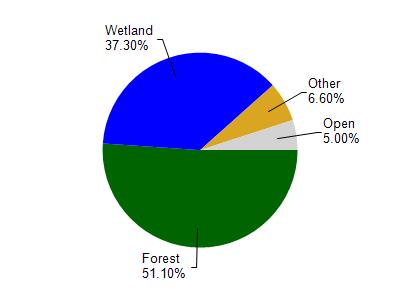Langlade
No
No
Yes
Fish and Aquatic Life
Overview
Enterprise Lake, in the Pelican River Watershed, is a 508.73 acre lake that falls in Langlade County. This lake is managed for fishing and swimming and is currently considered impaired.
Date 2015
Author Aquatic Biologist
Historical Description
Source: 1977, Surface Water Resources of Langlade County Enterprise Lake T-34-N, R-10-E, Sec. 4,
A soft water drainage lake having neutral, clear water of low transparency. The outlet, Enterprise Creek, flows to the Pelican River. The immediate shoreline is predominantly upland (95-.1) of hardwoods and conifer with the remainder being wetland (5%) of conifer. The littoral materials are composed of sand (50%), muck (20%), gravel (10%), rubble (10%), and boulders (10%). Fish species present include muskellunge, northern pike, walleye, largemouth bass, smallmouth bass, perch, bluegill, crappie, rock bass, bullhead, white sucker, common shiner, golden shiner, and creek chub. The lake supports a moderate growth of aquatic vegetation. Muskrat and nesting waterfowl use this lake. Developments on the shoreline include 85 dwellings, two resorts, a boat rental and boy scout camp. An improved public boat landing with parking is available on the south shore of the lake. Of the 6.09 miles of shoreline, 0.16 mile is public.
Surface Acres = 502.0, Maximum Depth = 23 feet, Secchi Disk = 4 feet
Date 1977
Author Surface Water Inventory Of Wisconsin
Impaired Waters
Enterprise Lake (WBIC 1579700) was placed on the impaired waters list for excess algal growth in 2014. The 2018 assessments showed continued excess algal growth; new chlorophyll-a sample data exceeded the 2018 WisCALM listing thresholds for the Recreation use. Total phosphorus data were clearly below the Recreation use and Fish and Aquatic Life use listing thresholds. Based on the most updated information, no change in the existing impaired waters listing was needed.
Date 2017
Author Ashley Beranek
Impaired Waters
Enterprise Lake (1579700) was placed on the impaired waters list for excess algal growth in 2014. The 2016 assessments showed continued excess algal growth; chlorophyll sample data exceed 2016 WisCALM listing thresholds for the Recreation use, however, total phosphorus data do not exceed REC thresholds. Total phosphorus and chlorophyll data were clearly below Fish and Aquatic Life listing thresholds. Based on the most updated information, no change in existing impaired waters listing is needed.
Date 2015
Author Aaron Larson
Condition
Wisconsin has over 84,000 miles of streams, 15,000 lakes and milllions of acres of wetlands. Assessing the condition of this vast amount of water is challenging. The state's water monitoring program uses a media-based, cross-program approach to analyze water condition. An updated monitoring strategy (2015-2020) is now available. Compliance with Clean Water Act fishable, swimmable standards are located in the Executive Summary of Water Condition in 2018. See also the 'monitoring and projects' tab.
Reports
Management Goals
Wisconsin's Water Quality Standards provide qualitative and quantitative goals for waters that are protective of Fishable, Swimmable conditions [Learn more]. Waters that do not meet water quality standards are considered impaired and restoration actions are planned and carried out until the water is once again fishable and swimmable
Management goals can include creation or implementation of a Total Maximum Daily Load analysis, a Nine Key Element Plan, or other restoration work, education and outreach and more. If specific recommendations exist for this water, they will be displayed below online.
Monitoring
Monitoring the condition of a river, stream, or lake includes gathering physical, chemical, biological, and habitat data. Comprehensive studies often gather all these parameters in great detail, while lighter assessment events will involve sampling physical, chemical and biological data such as macroinvertebrates. Aquatic macroinvertebrates and fish communities integrate watershed or catchment condition, providing great insight into overall ecosystem health. Chemical and habitat parameters tell researchers more about human induced problems including contaminated runoff, point source dischargers, or habitat issues that foster or limit the potential of aquatic communities to thrive in a given area. Wisconsin's Water Monitoring Strategy was recenty updated.
Grants and Management Projects
Monitoring Projects
| WBIC | Official Waterbody Name | Station ID | Station Name | Earliest Fieldwork Date | Latest Fieldwork Date | View Station | View Data |
|---|
| 1579700 | Enterprise Lake | 10003161 | Enterprise Lake | 7/27/1999 | 9/30/2017 | Map | Data |
| 1579700 | Enterprise Lake | 10043501 | Enterprise Lake - W (Herbicide Monitoring Site 3) | | | Map | Data |
| 1579700 | Enterprise Lake | 10043500 | Enterprise Lake - W Shore (Herbicide Monitoring Site 2) | | | Map | Data |
| 1579700 | Enterprise Lake | 343120 | Enterprise Lake - Deep Hole | 10/19/1973 | 8/31/2025 | Map | Data |
| 1579700 | Enterprise Lake | 10018734 | Enterprise Lake -- Access at Schuette Ln | 8/25/2004 | 8/9/2025 | Map | Data |
| 1579700 | Enterprise Lake | 10019790 | Enterprise Lake -- Access Nr Enterprise Lake Rd | 7/13/2008 | 8/9/2025 | Map | Data |
| 1579700 | Enterprise Lake | 10043499 | Enterprise Lake - W Shore (Herbicide Monitoring Site 1) | | | Map | Data |
|

Watershed Characteristics
Enterprise Lake is located in the Pelican River watershed which is 264.88 mi². Land use in the watershed is primarily forest (51.10%), wetland (37.30%) and a mix of open (5%) and other uses (6.60%). This watershed has 244.69 stream miles, 8,823.57 lake acres and 59,960.52 wetland acres.
Nonpoint Source Characteristics
This watershed is ranked Not Ranked for runoff impacts on streams, Medium for runoff impacts on lakes and Low for runoff impacts on groundwater and therefore has an overall rank of Low. This value can be used in ranking the watershed or individual waterbodies for grant funding under state and county programs.However, all waters are affected by diffuse pollutant sources regardless of initial water quality. Applications for specific runoff projects under state or county grant programs may be pursued. For more information, go to surface water program grants.